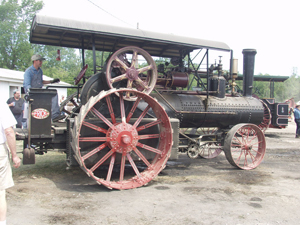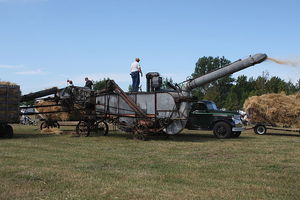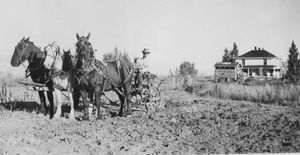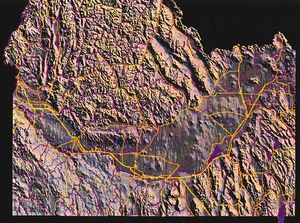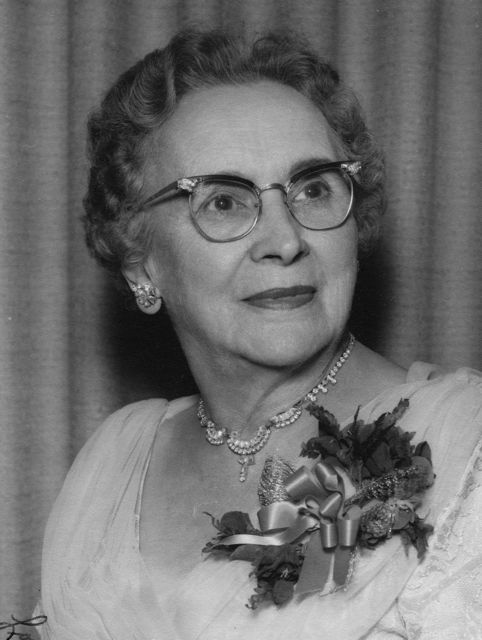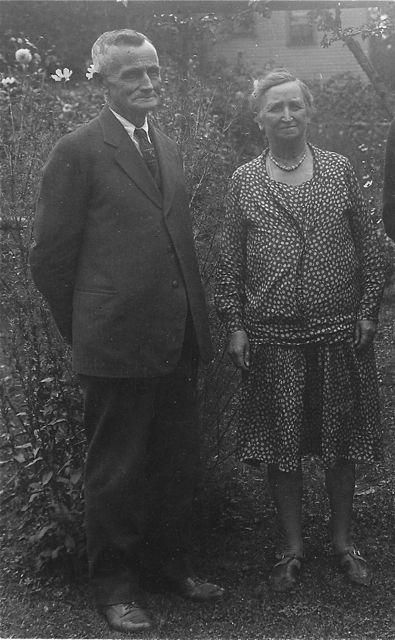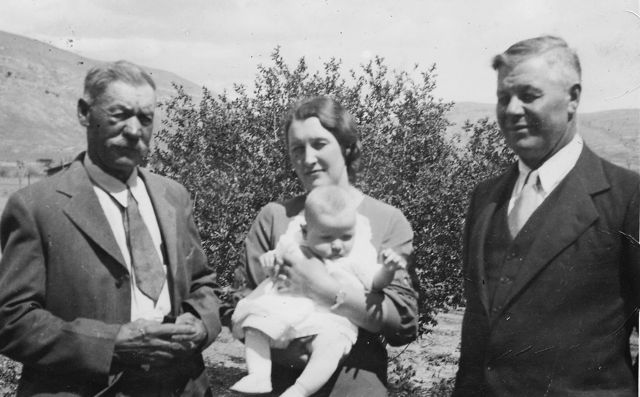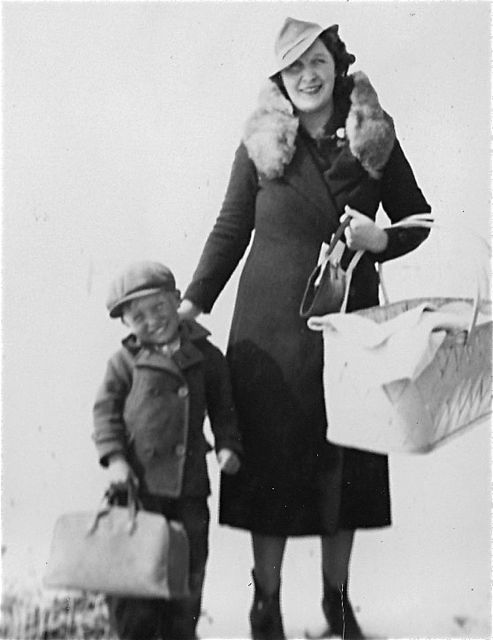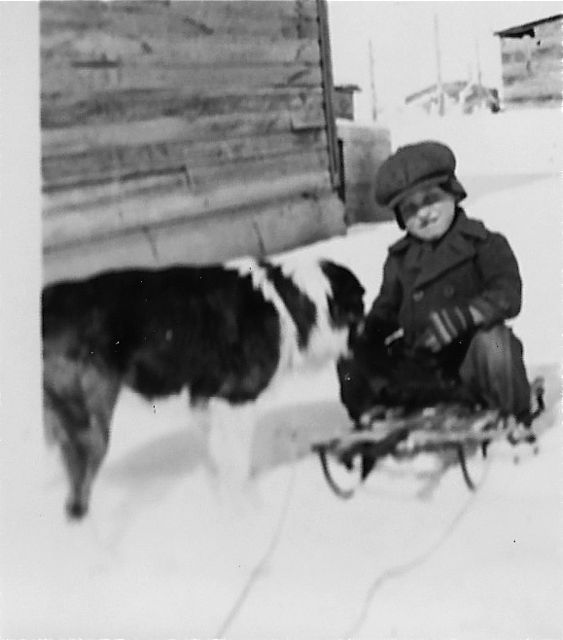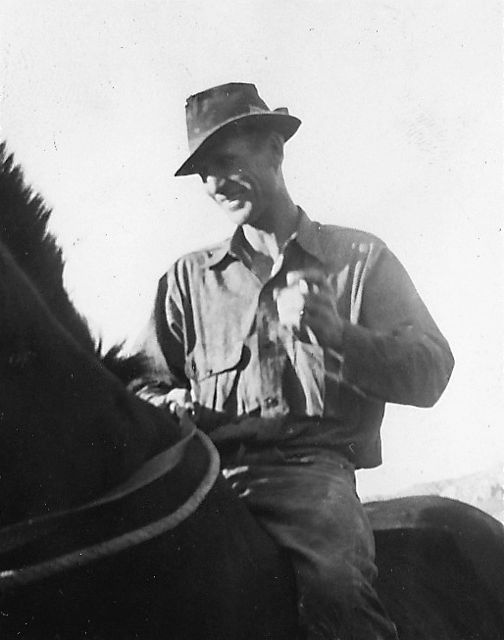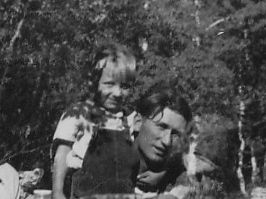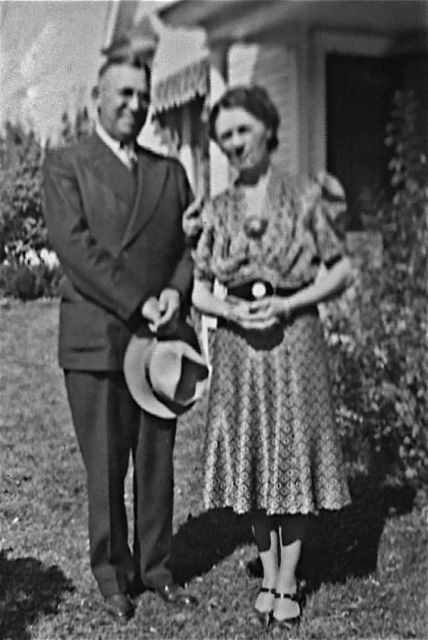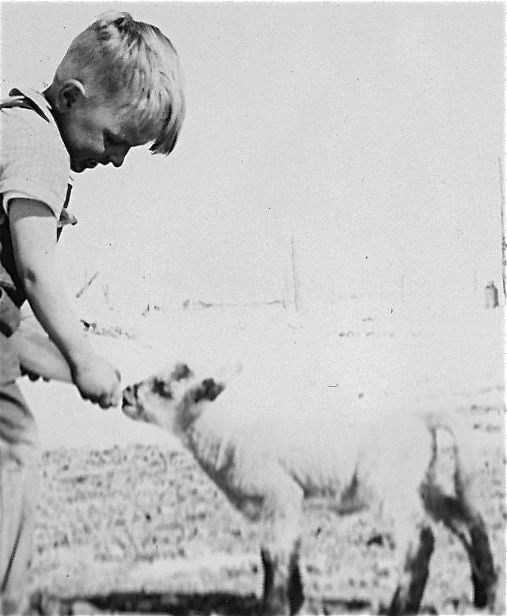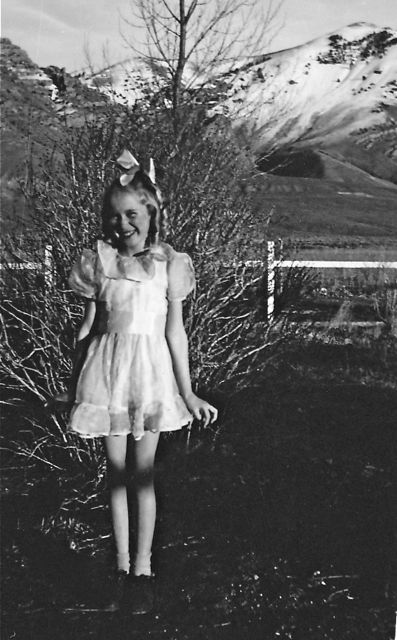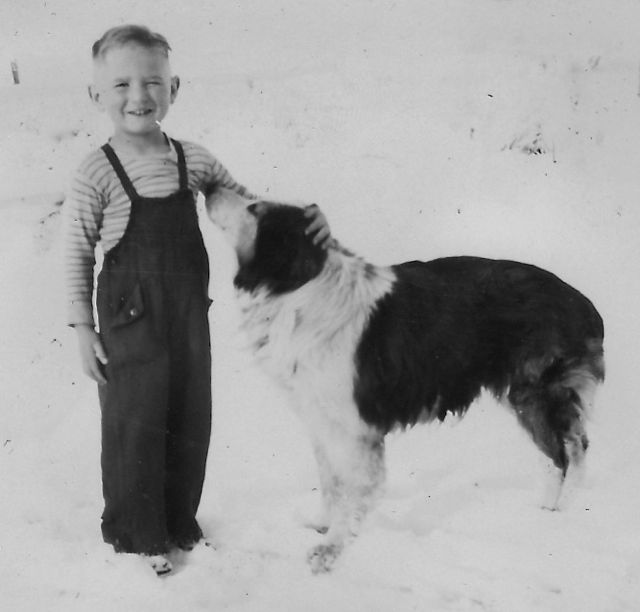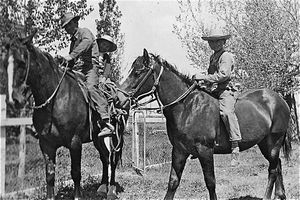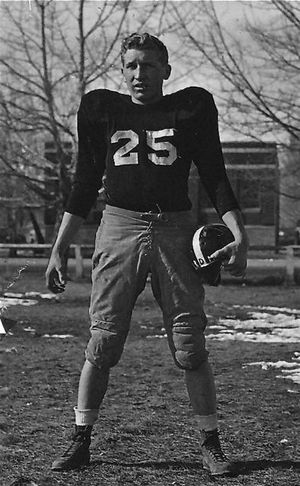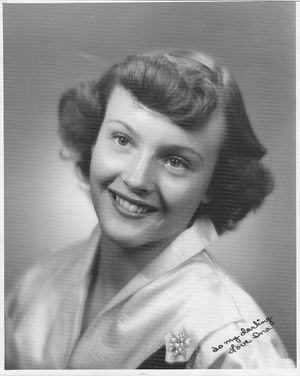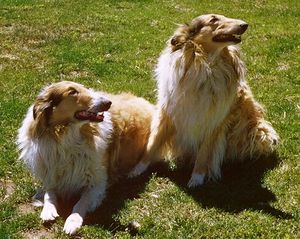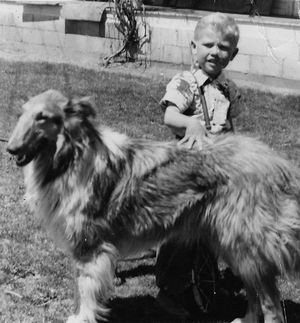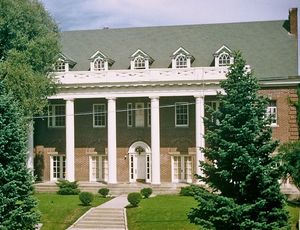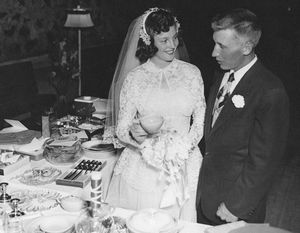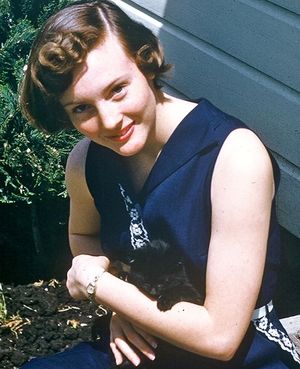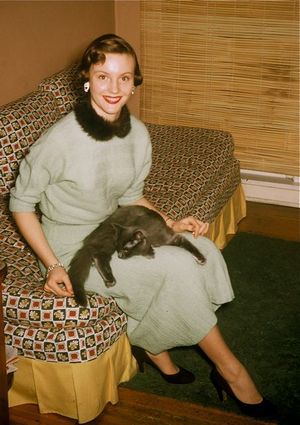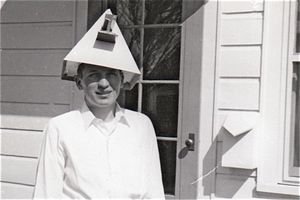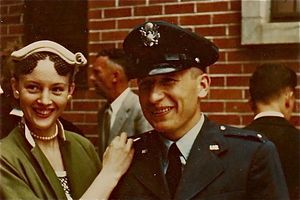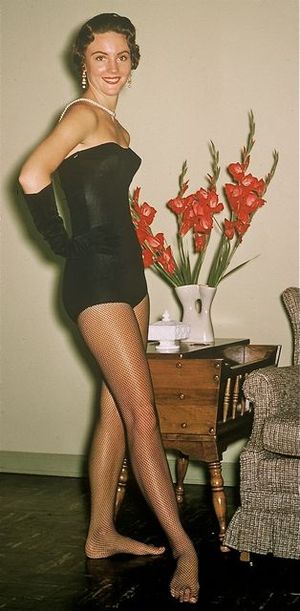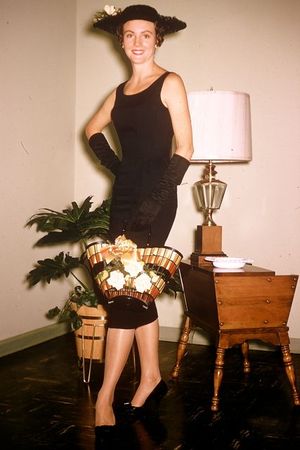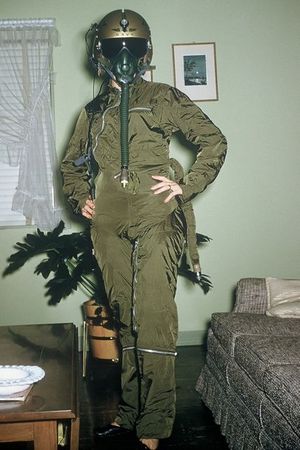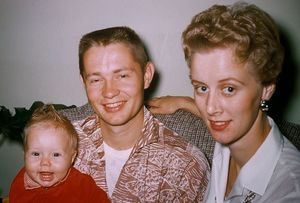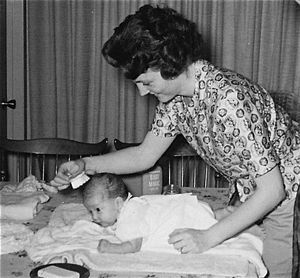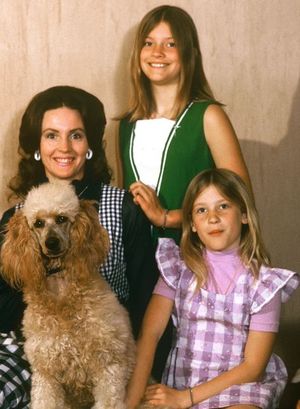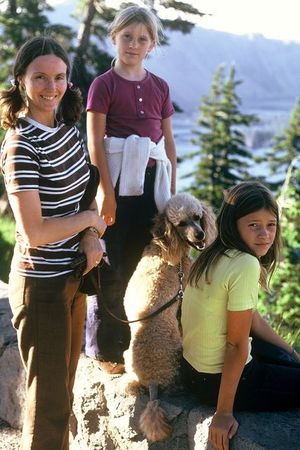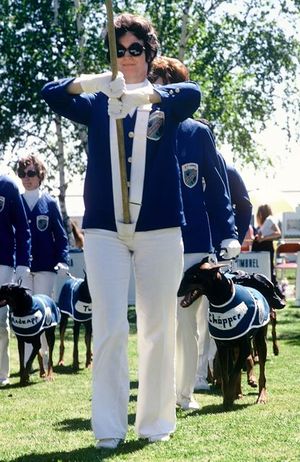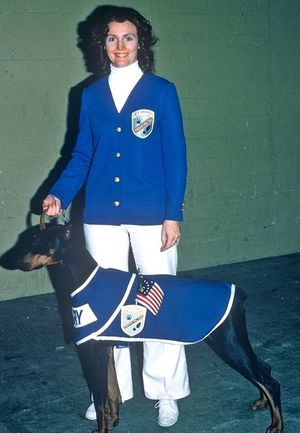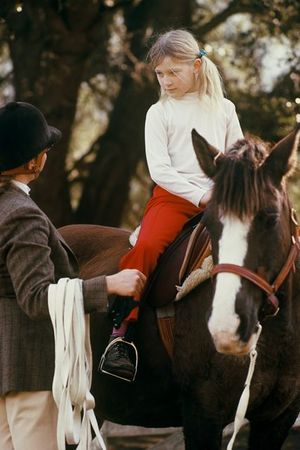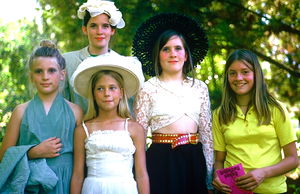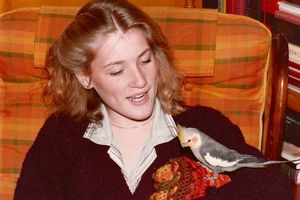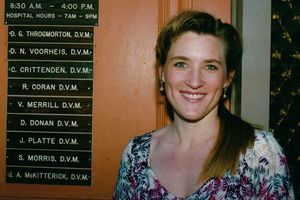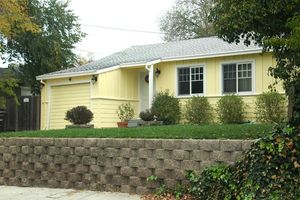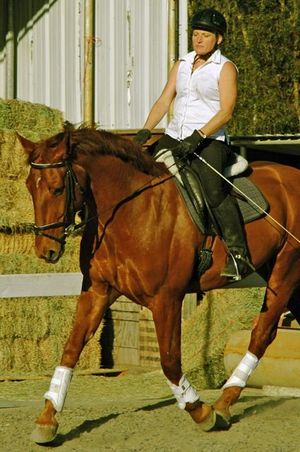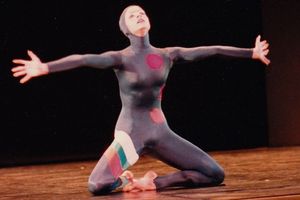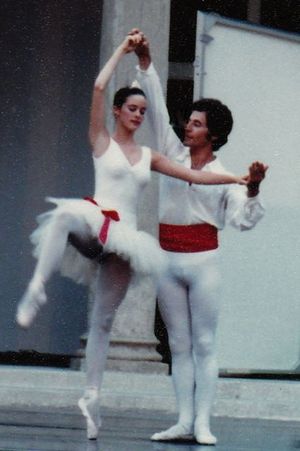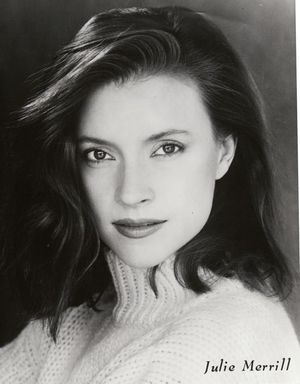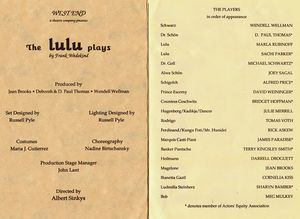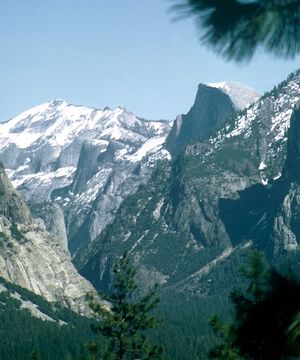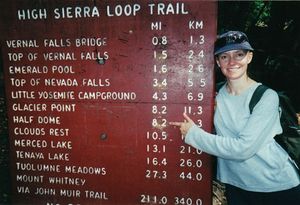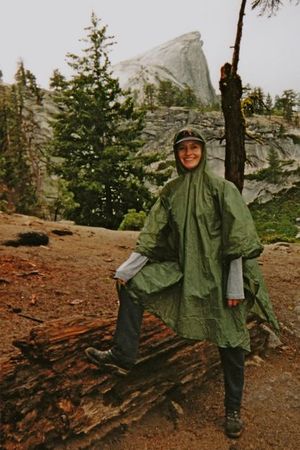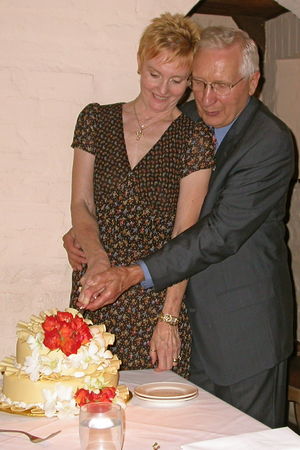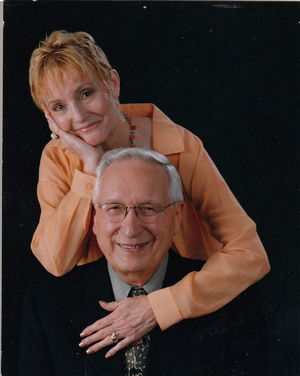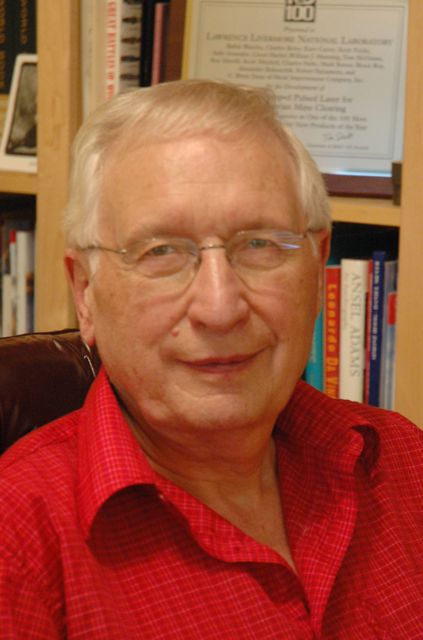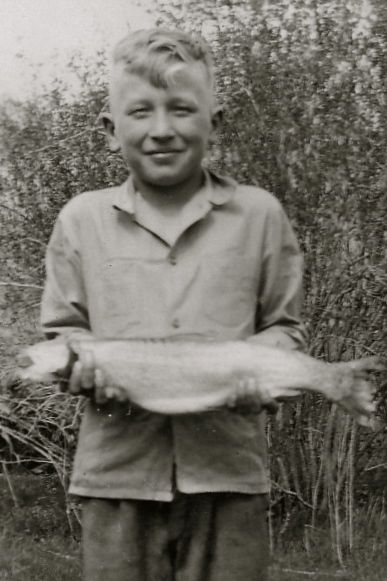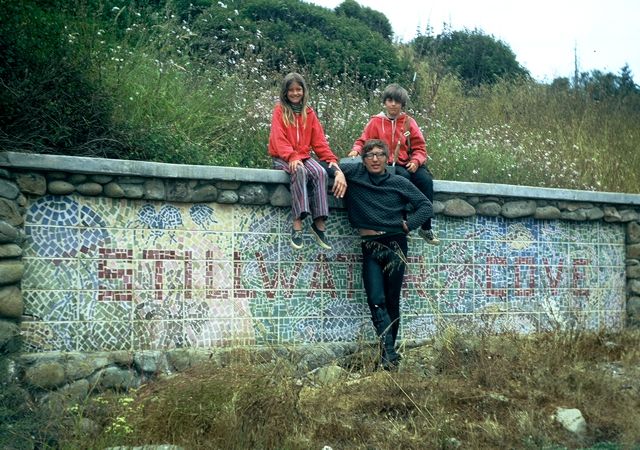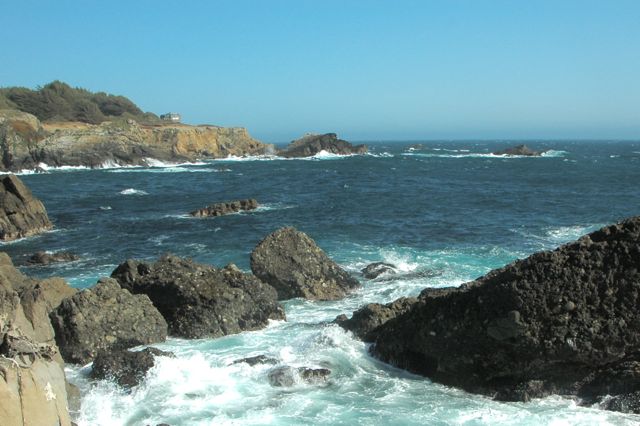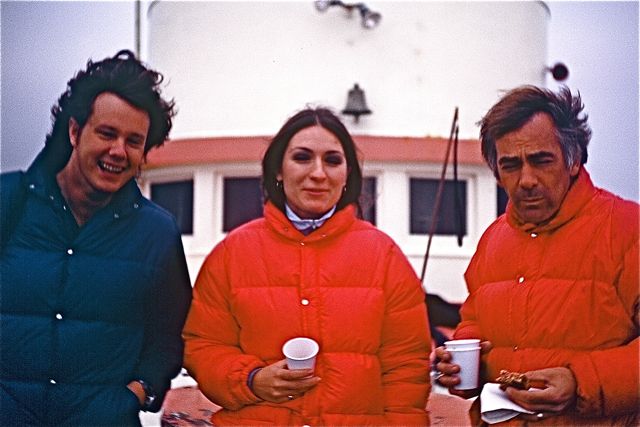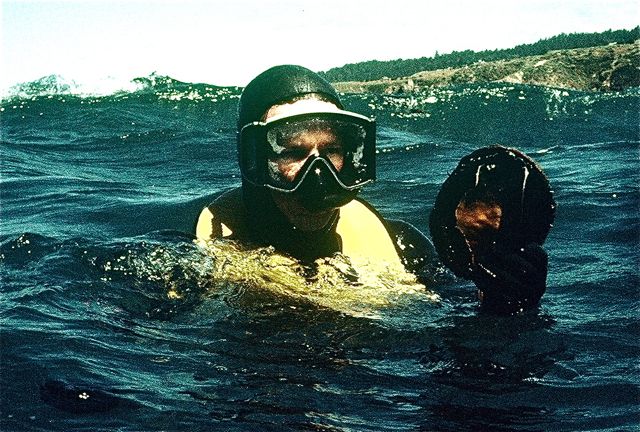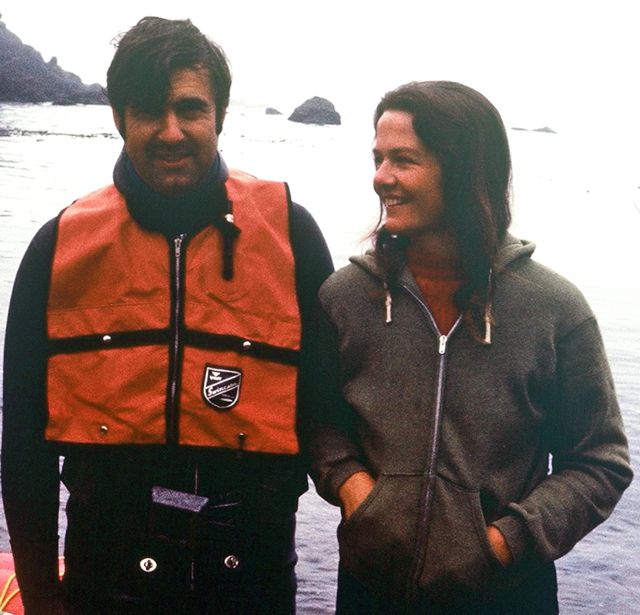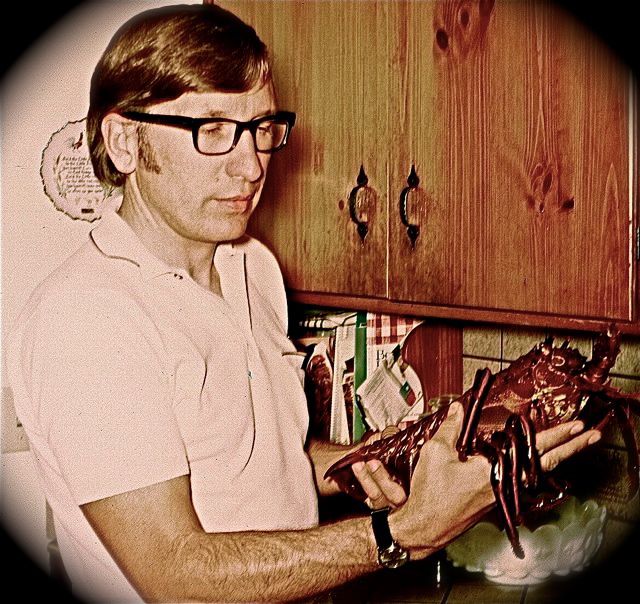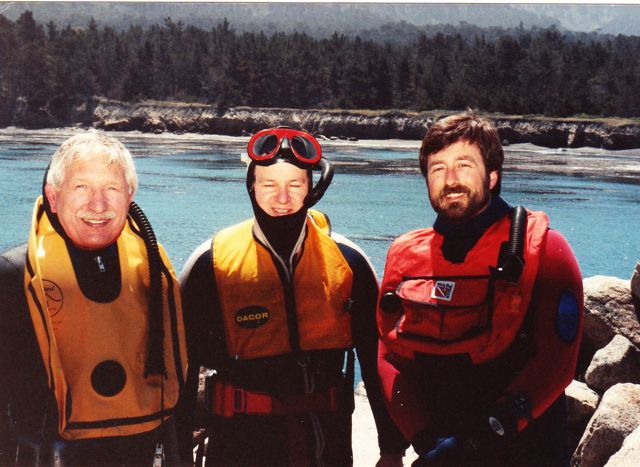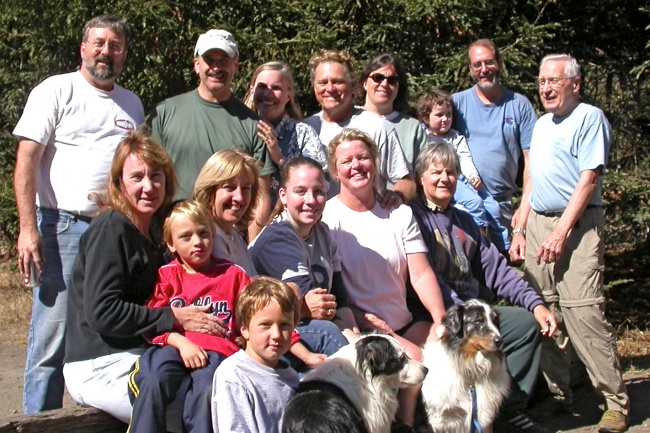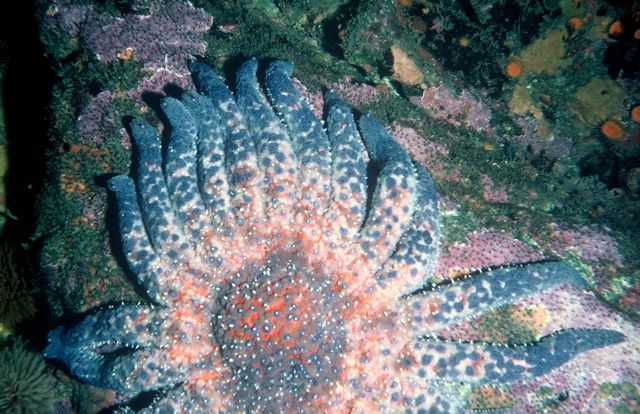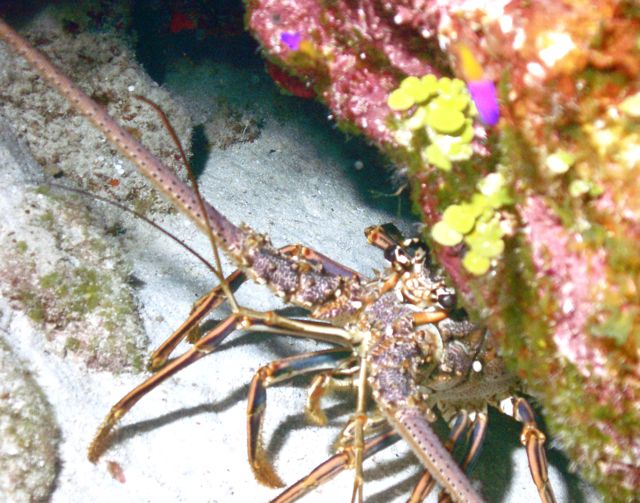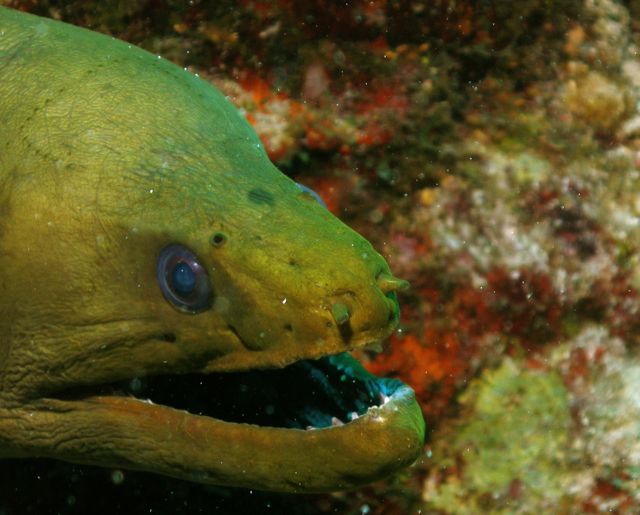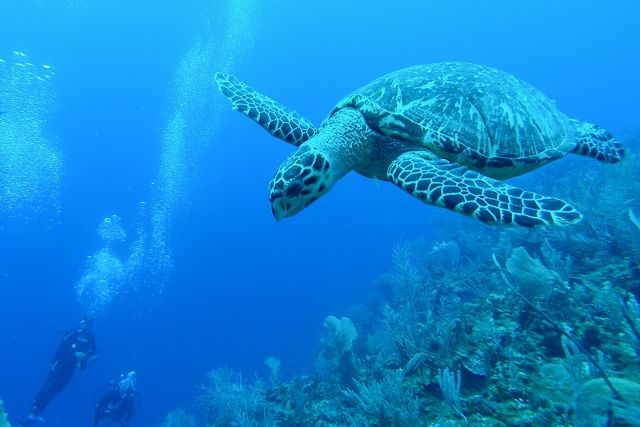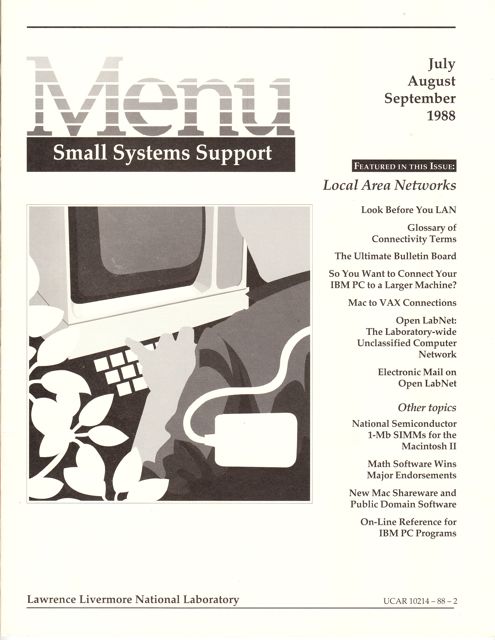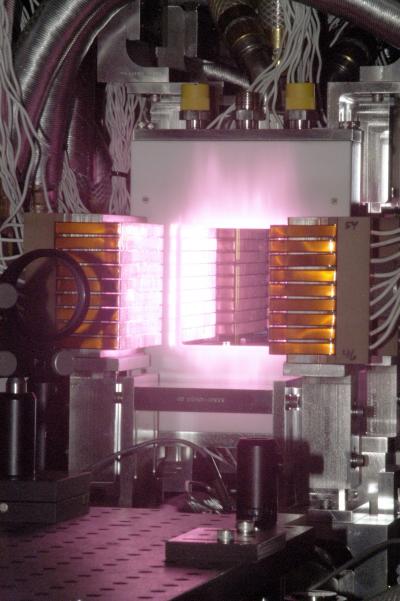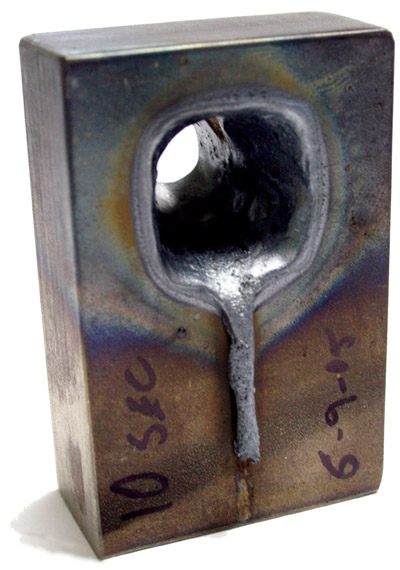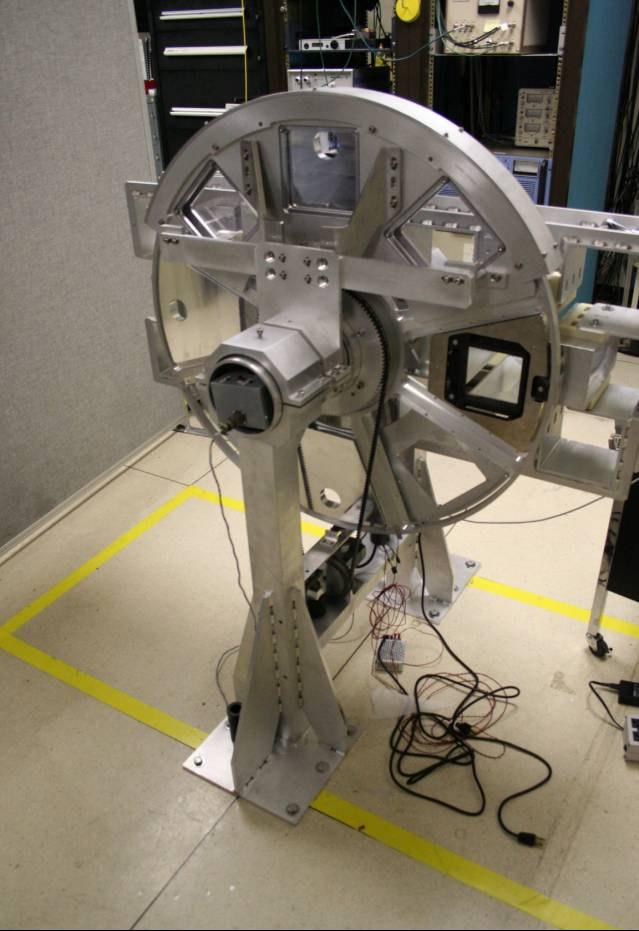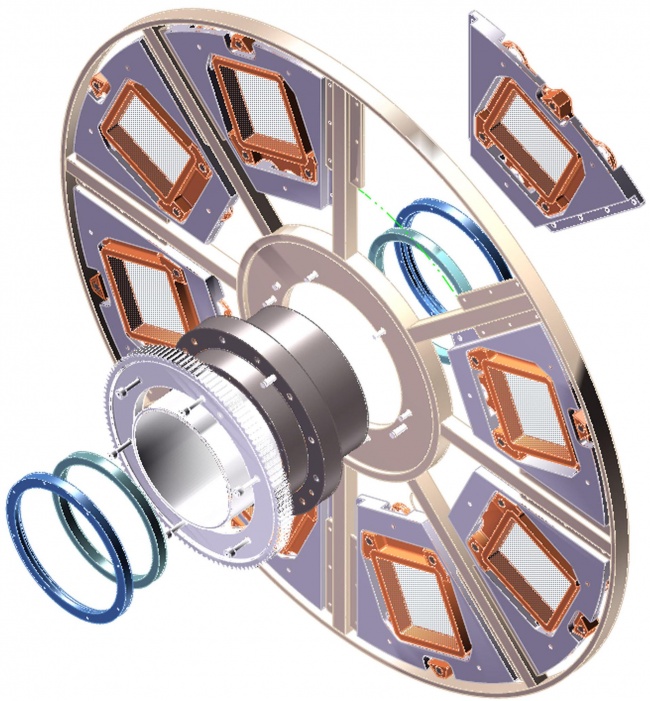First-Hand:A Brief Biography of My Life
Submitted by Roy D. Merrill, IEEE Senior Life Member
Chapter 1 - A Short Biography
First Vivid Memories
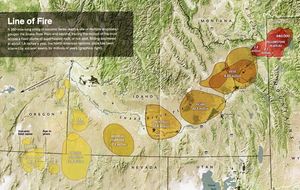
Early on, probably at age 3 or 4, my most vivid recollection was the taste of spearmint gum. Every time Aunt Evelyn visited us, Wendell Hansen, her boy friend, supplied a stick of that marvel. At that time we were living in My Folk’s first home on the Old Ferris Place in Old Arco.
Another vivid memory from that time was seeing a grain thrashing machine being pulled into the barn yard by a gigantic steam engine tractor. After the tractor had been unhitched, and turned facing the threshing machine, the operator strung a drive belt with a twist between the thresher drive pulley and the Tractor flywheel power pulley. With thresher wheels blocked, and tractor breaks set, the operator slowly let out the power clutch causing the drive belt to slowly move, and the thresher to start swaying, shaking and vibrating which steadily increased in intensity as the drive belt reached full speed. This fascinating harvesting dance by the thresher separated the wheat grains from the straw in a great cloud of dust. Whenever an unusually large bundle of grain entered the harvester mouth, the tractor hissed and belched steam more than usual as it strained to deliver the power needed to breakup the bundle, shake off the grain kernels and belch out the stream of straw. This sudden surge of power caused the long pulley driven belt to slap together with rhythmic resounding claps.
The time was early summer 1938, my fifth year. The following are memories of events occurring after moving to our second home, a farm the folks had leased from the Idaho governor-elect, C.A. “Bott” Bottolfsen and his wife, Elizabeth (Hanna) Bottolfsen. The farm situated in one quarter of the 'Hanna' section in the Big Lost River Valley, comprised 160 acres: 100 cultivated and 60 in pasture land. A Taylor Grazing permit for 25 head of cattle and a 1895 water right for irrigation from the Mackay Dam reservoir were an integral part of the farm. The Folks signed a four year lease with an option to buy the ranch anytime during the lease. That provision was one of the wisest decisions my folks made in that stage of their lives together, but more about that later.
The farm ranch house was a big rather majestic two story white four-bedroom home with eight white pillars supporting an extended roof over a raised wrap around porch on the east and south sides of the house, with two large lilac bushes, more like trees, on the east side. (We learned later that my great-grandfather, John Clendenin, pictured below, was the master carpenter that built the house in 1900.) The main entrance to the house on the south-east corner had a wide stair case leading to the porch and the front door which had a beautifully etched glass window. The house sat on a small knoll in the center of the cultivated portion of the farm land.
Our main irrigation channel started at a metering gate on the West-side canal up in Anderson’s farm just north of our farm and snaked down through their fields and ours and passed between the house and a fertile vegetable garden with a modest apple orchard on the West side. A sturdy log barn with 12 milking stalls and accompanying corral, hog shed (sty), chicken coop and machine shop made up the out-buildings located south down hill a little 150 yards from the house. The Union Pacific Railroad Company owned fenced railroad tracks in a right-of-away that ran north-south diagonally separating the cultivated from the pastured lands.
The farm flanked the foot hills just below Hanna Canyon in a towering mountain range delineating the East side of the valley. The ranch possessed a marvelous spring-fed creek originating in Harold Anderson’s ranch just north of us with schools of fingerling trout (many of which later grew up to be 3 or so pounds) in ripple ponds all along its meandering course down the pasture midlands. On the Middle-East side there was a long steep bluff with wild currants growing right down to the reed lined shores of a marsh. It was the habitat for large flocks of mallard ducks as well as a few teal and Canadian geese that dropped by during their spring and fall migrations. The pasture as well as the crop fields provided marvelous habitat for ring-necked (Chinese) pheasant, sage grouse, cotton tails and ever-present jack rabbits. The marsh and creek banks were havens for muskrat. The spring fed marsh dumped into Spring Creek on the Wight’s farm just south below ours.
The pasture comprised range grass, sage brush of several varieties, wild currant bushes, young cedar and cotton wood trees, willows, and knee-high cotton wood stumps scattered at random throughout the pasture land. These stumps were a reminder of the severe drought just passed that lasted seven or so years during which time there was very little Lost River water run-off available in the valley. The reservoir located some 35 miles north up the valley above Mackay, nearly went dry in the late 1920‘s and early 1930’s and only provided a merger water supply to just those few farms having early dated (1885) water rights. During this time nearly all cedar and cotton wood trees and willows died off. My folks leased the Hanna-Bottolfesen ranch the second or third year after this devastating drought ended.
The first floor of the Ranch house had been a wheat granary for many years before we moved in. Consequently, the stud walls covered with ship-lap lumber contained some grain kernels that were great feed for field mice. Mom became a very proficient rodent exterminator. Similarly, a honey bee swarm had settled in the north wall of the living room. They were very tenacious. I remember suffering numerous bee stings while playing on the carpet before the folks found an insecticide that successfully drove them from the house. Also, Mom had numerous encounters with rattle snakes. The most harrowing of these experiences occurred when she discovered a four foot dennison sun-bathing on the porch just outside the kitchen door.
Dad was a good farmer. He had little formal training; he had finished only the first four grades in Tetonia, Idaho where he was born. He learned the farming business while working for the Utah Construction Company in his early twenties farming a section of their property south west of Arco. After just a few years working for them, he became the foreman of some 30 Japanese immigrant workers raising potatoes. He supervised farming “Section 36" in the flat lands where the Big Lost River Valley opens out on to an expansive lava field. (This lava field, some 60 miles wide, separates the valley from the Snake River basin and extends west well beyond the Craters of the Moon National Monument at the terminus of the Big Lost River Western mountain range. It extends north-east through the Little Lost River Sinks and Mud Lake-Birch Creek region on up into the Yellowstone Park.. Visible south by southeast from Arco are the Big Butte, and Twin Buttes, all extinct volcanos dating back to eruptions some 6.65 millions years earlier. The SAR (side-looking aperture radar) and geological maps that follow illustrate that this region is part of the Heise volcanic field. Arco at the mouth of the Big Lost River Valley lies north-west over this expansive lava field some 60 miles from Idaho Falls.)
The following photographs are of my Grandmother Clendenin with her folks; me with my Mother, Granddad and Great-Granddad; me with my Mother and baby sister Caralee, and with Bob, our Shepard; Dad on his Morgan; and with me on a picnic; the Governor and his wife; me feed one of our bum-lambs; Dad with Sharon, my sister, and her kitten with Bob; Sharon in a pretty dress; and Dale, my brother, with Bob.
Dad detested raising potatoes even though they were a popular cash crop in Idaho, because he said, "I've harvested enough of the dang things to last a life time while working for the Utah Construction Co." At that time, he ended his career with UCC while managing a large group of Japanese labors raising potatoes. He was to compromise his no-potato farming resolution just one time to my great advantage as I will relate later. Dad's farming method was to milk a herd of some 12 Jersey, Guernsey, and Holstein cows; and sell the milk to the Kraft Cheese Company as a monthly cash source. He raised a large crop of alfalfa each summer season to feed these cows, their yearly calves, a small herd of 25 or so Hereford range cattle, four work horses and two saddle ponies. He also raised enough oats & barley to feed some 50 head of pigs for market in the fall and winter seasons. The 60 acres of pasture and marsh served as grazing land for the cows, calves and horses during the spring, summer and fall. Most of this pasture land was watered by the subterranean aquifer that surfaced just to the south of the currant bush bluff on the east side. He irrigated all the alfalfa, oats, and barley crops with water from the east-side canal. This ditch was fed from the Lost River Moore diversion which in turn was carefully metered out through the Mackay Dam water gates some 35 miles up the valley.
Dad worked very hard; his day started at 5 a.m. rounding-up the cows and milking them, feeding the stock, and during the summer, setting the irrigation canvas dams for the next field to be watered. Following a big breakfast, he and us kids, as boys became old enough to wield a shovel or hoe, drive a team of horses, ride a pony, milk a cow or drive the tractor, would be directed to help with these chores. When this work was done and we all had breakfast, we were prepared for the day’s labor starting at 8 am. Typically, when harvesting the hay or grain, we stopped at noon for a hardy lunch, the largest meal of the day, then back to the fields for the afternoon's effort until 6 p.m.. We then knocked off for the day and headed back to the corral. There the horses were unharnessed, curried and fed oats & hay, and the cows were rounded up and milked before supper, typically by 7:30 p.m.
Mother’s day was equally long and strenuous involving cooking, washing, cleaning house, feeding the chickens, maintaining the garden and orchard, etc.
Mom & Dad had very few vacations or holidays as the cows needed tending twice daily. Their time for relaxing often amounted to taking the family visiting relatives in Arco, or friends in the valley, or taking a long Sunday drive. These driving excursion which they particularly liked, was to drive up the valley through Moore, Darlington, passed the Antelope Creek and Pass Creek crossings, through Mackay and on up above the Mackay Reservoir, then west across Barton Flats and up past the Copper Basin Lost River water shed access, then over Trail Creek Summit to Stanley Basin & Redfish Lake where we would picnic, and maybe trout fish for a short time. Sometimes we would continue on south through Stanley basin and up over Galena summit into Wood River Valley passed Sun Valley where we all had an ice cream cone before heading back home through Ketchum, Hailey, Carey, through the Craters of the Moon National Monument, and Arco to the Lost River Valley. All-in-all we would have traveled about 200 miles on a 12-hour outing. On arriving back home, the cows would first be milked before a supper, usually salt and peppered sliced onions in bread and milk. Believe it or not; I developed a taste for that concoction!
A Successful Ranch Purchase
I spoke earlier of the wonderful consequences of the folks leasing the Hanna Lost River Valley ranch for four years with an option to buy. Remember, they moved onto the farm about three years after the end of a very sever drought in the Lost River Valley. (Farming was very difficult in the mid-1930s because of the Utah Construction Company had somehow gained control of the Mackay Dam water rights during the Great Depression. Consequently, they had the legal right to divert all the Lost River flow into the West-side canal south down the Valley and out to the flat lands at the mouth of the Valley to irrigate their crops. There with the rich volcanic soil, they raised bumper crops. It was only after the farmers of the valley regained control of these water rights, that this travesty was corrected. (How they did this will be researched later!)
The pasture was a true witness to the droughts severity. Virtually, all cotton woods, cedar trees and willows had died. The cotton wood trees had been chopped down for fire wood no doubt during the long 7 year stretch without water. In the three years that followed, all of these species began recovering with young seedlings and suckers from the old stumps growing back rapidly. Within another three years, it was clear the valley had experienced nearly a full recovery. Moreover, WWII had begun. Because of these circumstances, and the fact that Dad was given a framing deferment, the folks decided to buy the place.
Surprise! Bott had other ideas. By this time, he had been elected Governor of Idaho a second time, and could see by then, that the place was worth considerably more than was agreed upon in the original lease contract. With the persistence and deviance's of a slum landlord, he tried to break the contract, but to no avail. Because the folks had a solid contract, the President of the Arco Bank, Mr. Habel, was quite willing to loan them the purchase money. Finally, Bott gave in reluctantly. As testament to Bott's good nature, they remained congenial friends there after.
“My Friend Flicka”, a popular movie of the time when I was 10, excited my interest in having a pony of my own. Dad quickly understood how I felt, and suggested we attend the mustang round up auction held in Blackfoot every other spring. Some resourceful cowboys had been rounding up the wild mustangs from the BLM crater desert between the Snake River basin and the rocky mountain range for many years. It was an exciting event and one that was completely new to me. I soon caught the eye of the auctioneer who asked if I might fetch him a drink of water every hour of so; which I did with a reward of 10 cents or so for each trip. I was so excited searching for a pony we could bid on as each batch of horses were driven into the auction ring. Dad soon spotted the horses he wanted, and successfully bid on them. He ended up buying a 2 year pony for me and a 3 year old mare for himself. Later after training and riding this stock, I come to realize Dad had been a good judge of horses.
Within a year after buying my Flicka, she was ready to be “broken” to ride. This phrasing did not quite describe how I really trained her, however. With Dad’s coaching, I first herded Flicka into our stock corral, then lassoed and haltered her with a long lead which I held while urging her to move around the corral. She didn’t like that one bit and proceeded to tug and pull and buck her way around the corral until she was worn out. At that point, I tied her up with a short halter lead to a post in the center of the corral. Carefully, I approached her talking softly and running my hand gently down her neck, then along her wethers and onto her back. I used this method the next few days, each time going a little further scratch her ears and rubbing her nose, then placing a saddle blanket on her back, then swinging the saddle over her wethers, then cinching the saddle strap under and around her belly; after each session rewarding her with a hand full of oats. After a week of this daily routine, I placed my weight on the saddle stirrup; then swung my leg over her back and settled into the saddle. Again I repeated this routine several days until she accepted each step calmly. Following Dad’s instructions, I saddled Dad’s horse as well as Flicka for a ride out of the corral. After Dad got on his horse, he took her halter lead, and snubbed it to his saddle horn; I then got on Flicka, and we walked the horses out of the corral, around the pasture, then back into the corral, then back out again, etc. After several days of this routine, Dad suggested he just hold Flicka’s halter lead while I saddled her and got on. This went so well, we decided to solo. All went well and after several successful sessions, we decided Flicka had been broken, and done so without any spurred bucking, etc usually depicted in the movies.
At about the age of 11 or 12, I screwed up my courage enough to ask the folks for a regular allowance. They considered my request seriously, and instead recommend that I get a part time job or business that could provide a steady income. I was at a loss what to do until Dad suggested trapping muskrat for their pelts.
Our ranch had a spring creek that ran briskly year around, and several marshy ponds that were excellent muskrat habitat. The folks bought me a dozen spring traps to start with, and suggested I scout our place for muskrat runs and boroughs. With a few false starts, I taught myself how to catch the wily creatures and successfully stretch their hides to produce marketable pelts. I soon learned to check my trap line at least every other day to insure any catch didn’t fall prey to other predators. Later I added to my trapping territory by gaining permission from our close neighbors to trap on their property. It was then that I discovered I had competition; our Arco Druggist, Hugh Weatherington. We never actually met in the field to discuss this, but we both were careful not to molest the other’s trap line. After one season of sharing the territory, he failed to return.
My sturdy mustang mare, Flicka, provided transportation, and the folk’s cellar, a place to skin and stretch the hides for drying. After an early learning period, I managed to catch 1 to 3 muskrats a week. With some searching, I soon learned to side step the local buyers for a better price by shipping the pelts to a Wisconsin buyer who payed $1 to $2 a pelt.
A Special Cash Crop that Funded Two Years of my University Education
The story about why Dad's agreeing to raise just one crop of potatoes, turned out to be a pivotal point in my life: remember, Dad was dead-set against raising potatoes. However, in the spring as my high school graduation date drew near, a decision had to be made on how to finance my University of Idaho education studying Mechanical Engineering. It helped that at the time there was a chance I might receive an football athletic scholarship.
It seemed a University football scout had attended our last game of the season against Hailey and was impressed with my sprinting speed and strength as a pulling guard in offense, and tackler in defensive plays. Their proposal was that I attend the University football preseason training camp in the fall where I could be coached and my abilities assessed to determine if I was college ball material.
Dad had always said, "we want you to get a college education, because that is the one thing 'They’ cannot take away from you." Two of his cousins, Lloyd & Keith Merrill, had worked for the Morris/Knudson Construction Company overseas, and had acquired big construction equipment knowledge and skills. On their return, they visited Dad and told him stories of their high adventure. I listened completely entranced. It was then that I first considered becoming an engineer. By that time, one thing was definitely clear, I did not want to be a farmer!
In the spring of 1951, my high school graduation year, Dad decided that one means of acquiring the money for my first two college years would be to raise a big crop of russet potatoes. We had, just two years before that time, broken up 20 acres of sage brush pasture into cultivatable land.
In preparing to obtain irrigation water for this land, Dad consulted Harold Anderson, our northern neighbor whose pasture was the water shed for our Spring Creek, to obtain permission to divert a small portion of the upper reaches of the creek. He was quite agreeable to Dad’s proposal, so we built a diversion dam and a connecting ditch or small canal, surveyed by Les Jardine, from there to irrigate our newly cultivated 20 acre parcel on the East side. With that parcel and another 20 acres Dad had just rotated from alfalfa, we planted a 40 acre potato crop.
We turned to Harold Anderson again to help us out, and he very graciously loaned his planter and cultivator to us when he was not using them so we might carry this venture off without a big investment in farm equipment. The hot three month growing season together with the rich Volcanic loam of the newly cultivated parcel and one just recently crop rotated, all came together to produce a bumper crop of potatoes. So successful was the harvest, and the price of potatoes that winter so high, Dad & Mom were able to clear enough money to cover my college expenses for two years!
During that summer, besides planting, irrigating, and cultivating the potato crop, I worked for Herman Aikle operating his John Deere self-propelled grain combine. He had leased the rights from the Cattleman’s Association to harvest the crested wheat off the wild range pasture land in the upper Arco Pass Valley. I worked in the evenings and on the weekends to accomplish this task, and made enough additional money to cover my expenses attending the University in the fall, and until Dad could harvest the potato crop and sell the first of several sorted portions of the crop over the fall and winter seasons.
The Love of My Life
In the spring of my senior year, I met the girl of my dreams! Her father, O.T. “Warren” Warren, an electrician, brought his wife, Gladys, and two teenagers, Ina Sue & John, to Arco. They were following the construction employment opportunities in building the Atomic Energy Commission (AEC) material testing nuclear reactors on the old Naval Bombardment Gun Test Range on the Arco desert. He and his wife built a mobile home park on the outskirts of Arco. When I first met Ina Sue, I discovered she was lovely and enchanting; we hit it off right away. I think within just a few weeks we had fallen in love. She was excited about my university plans, and in that summer I gave her a birth stone ring to celebrate our engagement.
Our courtship was very magical. We dated at every opportunity from picnics; to movies; to dancing; to horseback riding; to helping Dad pickup a truck load of lodge pole pines from Sawmill Canyon. When it came time for me to report to fall college football training, we both agreed to continue dating together for the next two years until Ina graduated from high school. Then, if we both still felt the same, we would get married that summer.
I think these factors all influenced my decision to definitely become an engineer. The only hitch in this plan was the money necessary to send me to school for at least two years. At that time, Ina had agreed that after our marriage, she would put me through the remaining two years at the University before she attended college.
The University of Idaho Football Coach called to let me know the fall training camp was to begin the first of August. I was familiar with the campus since a year earlier as a member of the Butte Count 4H Club livestock judging team, I had toured the University. Consequently, I knew something of how the campus was laid out, and felt comfortable joining the training camp. The football practice sessions were very strenuous, but they fed us like Kings. I enjoyed the experience and learned a lot about the pulling guard tackling and blocking duties. Unfortunately, at eighteen I was not yet fully grown, so by the end of the training camp I weighed in at 155 pounds. That was just a little below the coach’s weight limit for that position. He called me in, and congratulated me on the skills and knowledge I had acquired, but recommended I sit out one season, eat lots of steak and invest several hours a day lifting heavy weights. He predicted that with that regimen, by the following year I would be at competitive weight. I thought about his offer for several days, but in the end concluded I would be too busy attending class and studying the engineering courses to also be in a rigorous conditioning program.
As it turned out, that was a fateful decision. I found very early in the first semester that my high school mathematics and English training was grossly inadequate. Consequently, to catch up I had to spend twice as much time studying as my class mates. It took both my Freshman and Sophomore years to achieve that capability. Surprisingly, I was to find out that this extra effort resulted in my developing very disciplined study habits. That hard earned capability was to stand me in good stead through out my subsequent undergraduate and graduate studies. In fact, I had several class mates that coasted through those first two years, but found they could not hack the Junior and Senior engineering curriculum, and eventually dropped out of school!
While in football fall training camp, Dave Porter, a 3rd cousin on my maternal grandmother’s side of the family, asked me to join Kappa Sigma, his social fraternity. After visiting with Dave and has fraternity brothers, I decided to become a pledge. That turned out to be a very good decision. They helped with school work, and taught me a lot of much needed social skills. The biggest pay off was interacting with a fine group of upstanding, intelligent men. I made many life long friends while living in the Fraternity.
I was to experience yet another surprise during my Freshman year; the draft board planned to call me in the army to fight in the Korean War! My Fraternity buddies coached me on obtaining a deferment by joining either the Navy, Army or Air Force ROTC. I tried out for the Navy, but again found my poor high school training had not prepared me for their entrance exam. I elected then to join the AF ROTC with the promise of a 2nd Lt. commission at the time I receiving my BS (ME) degree. That turned out to be a better alternative for me because I soon developed a keen interest in becoming a fighter pilot.
In my first two years studying mechanical engineering, I was initiated into the Kappa Sigma Fraternity, Gamma Theta Chapter and completed all the elective courses in the M.E. curriculum. Aside from it being the most challenging endeavor I had ever undertaken, it was also the most rewarding both from an academic and social point of view.
The most important event in my life was marrying Ina. She had faithfully waited for me during my Freshman and Sophomore years while finishing her high school education. From the depth and strength of our love, it was clear we really wanted to get married. On August 22, 1953 we were married in the Arco Community Baptist Church. Dad was my best man; Rodney Romeny sang for us; ina & her mother Gladys planned a beautiful ceremony and reception. It was an incredible experience. We honeymooned in a snug little cottage with a crackling fire place on Redfish Lake in Stanley Basin. It rained almost all the time we were there, but that didn’t matter at all. We enjoyed every minute of it!
Ina was hired as a receptionist/secretary for Dr. Alley in the University Infirmary that fall. She was a real champion, particularly that first year of our marriage; our first home was in the Campus Motel, converted to married student housing during the school year, located about a mile from the infirmary. We did not have a car then so Ina had to walk all that distance, more than half of which was up a long sloping hill. The Moscow winters were cold and snowy, but Ina braved through that year without one complaint. In our second year, my Senior year in M.E., we leased an attic apartment from my Mechanical Engineering Prof. Henry Silha. It was just across the street from the engineering building complex, and about 1/2 mile from the Infirmary. It was far more convenient for both of us. During my senior year, I had two, sometimes three, engineering reports to prepare each week. My grades on these reports were very high particularly because Ina checked my spelling & grammar, and typed them up so well during lulls in her work.
In my third & fourth years, the engineering curriculum seemed much easier. I attribute that to the depth of my freshman & sophomore training, as well as the good study habits I developed during that time. Actually, I think I left out the very most important reason for my success during that time; our marriage. Ina brought happiness and stability in to my life beyond my highest expectations. In addition to that, she put me through the next three years of undergraduate studies. My grade-point average increased one full point!
As a result of my 3.6 point grade average, I was placed on the Dean’s List, and initiated into the Sigma Tau Engineering Honorary (see me in initiation hat below), and the Air Force Arnold Air Society. Later in 1955, I became a Distinguished AFROTC cadet Major and leader of the Eugene Beebe Squadron of the Arnold Air Society. Also during our Air Force Cadet summer camp, I was selected to command D-Squadron the first week, Captain Kirkman, our instructor, told me later after we had achieved the Wing’s Honorary Squadron award, he felt that it was due in no small part to my leadership that first week of camp.
I also was elected the Chairman of the American Society of Mechanical Engineers Student Chapter and voted “Outstanding ME” student of the ASME Student Chapter in my senior year.
In the spring of my senior year in M.E., the Air Force informed me that because the Korean War had stopped, they no longer urgently needed pilots. Hence, I would not be called-up for duty for at least one, possibly, two years, after graduation. This posed a new problem in our career plans; how should we use that intervening time to best advantage? I discussed our dilemma with the AFROTC Commander and my Engineering Dean, Prof. Janseen.
One suggestion came out of those conferences that seemed ideal: with one summer school class which Prof. Hattrup graciously offered to teach, and one additional year of senior electrical engineering study, I could earn a second B.S. degree in Electrical Engineering. On June of 1955, I received my B.S.(M.E) degree and 2nd Lt. commission in the USAF, then with the summer class taken while working for Professors Bill Parish & Doug King as a carpenter’s apprentice to help them build a new home In Faculty Heights, I began my senior year as an E.E. student. With that accomplished by June of 1956, I received my B.S. (E.E) degree.
We took leave of wonderful old University of Idaho in June, and began a leisurely car camping vacation over the Palouse Hills and across Washington along the Columbia River; down the Oregon and California Pacific coasts, and across the Arizona plateau to Albuquerque, New Mexico. There I began my first engineering job with Sandia Corporation’s Special Weapon’s Safe & Arm Engineering Section in July 1956.
Ina Stretching Her Wings and Raising a Family
Ina working at the U of I Infirmary, had put me through 3 years of undergraduate school. After we arrived in Albuquerque, Ina considered attending college, but in view of our short stay, decided to attend modeling school instead. She so impressed her instructor Mrs. Clark, that she hired Ina to teach classes in deportment, styling, and makeup to young women. Later, she hired Ina to perform clothing modeling in style shows for dress shop and tea room presentations and local TV. Ina was a natural, she was beautiful, photogenic and presented stylish clothing very gracefully both before potential buyers as well as on TV.
Near the completion of my AF service, Ina & I decided to start our family. Just after we moved to Mt View, CA, in 1961 Ina delivered Julie, our first born. In that year we also bought a three bedroom ranch-style home on Meadow Lane in Mt. View, CA.
Each of the women in my life found their own interests: Ina while raising the girls with very little help from me during the early years while I was working at the Lockheed Palo Alto Research Lab. and attending Stanford graduate school, led a junior girl scout troop, and joined the Doberman Drill team with her dog Berry; Valerie with her intense interest in living things from parakeets, pigs, dogs and horses to name just a few; and Julie with here budding interest in ballet dance, painting and staging plays.
During this time Ina was busy raising our family. The following photo also includes our first family dog Babette, a standard poodle. With the children in school, Ina finally had time for her favorite hobby, dog training. Her first achievement was acquiring a CD for Babette. As part of that experience, she bought a doberman, Berry, and joined the Los Altos Doberman Drill Team. As well as marching with the team in holiday parades, and Cow Palace Dog Shows, she also trained Berry to obtain a CDX certification.
Ina also lead a junior girl scout troop; and during that era we did a lot of family camping in Yosemite, Big Basin, Carter Lake and the Pinnacles National Parks.
Valerie with her accomplishments raising a litter of hogs, and volunteering in veterinary clinics, and her excellent grades was accepted in and graduated from the UC Davis Veterinary School with a Degree in Veterinary Medicine. From Valerie’s horse back riding hobby, she has become an accomplished Dressage equestrian.
Julie was accepted into UCLA and graduated with a BA in Fine Arts. After a serious groin pull and ligament tear, Julie had to give up ballet dancing, but continued on to become a successful professional actor in stage plays, TV screen productions and commercials. Julie, in her spare time, has become an accomplished miniature doll clothing designer. As Julie’s acting career came to a close, she began writing; her first “Roman Romantica” is nearing completion; she found that finding a publisher presented some problems without a literary agent. While solving that issue, she has been working for Wolfgang Puck’s catering business. Earlier in 2011 she decided to go back to school and has been accepted into the Chicago School of Professional Psychology. She just now is completing her first semester of study, and finds the subject to be quiet interesting.
Julie and I have hiked to the bottom of the Grand Canyon and stayed over night at Phantom Ranch. In that outing, we hiked 6 miles descending over 5,000 feet to the river. As we neared the bottom and were about to cross the Colorado River bridge, I became extremely short of breath and had to rest every 100 feet or so. Julie realized something was seriously wrong with me and insisted we stop on the other side of the river at the Angel Creek crossing even though we were within a stones throw of the Ranch. Believe it or not we found there a young doctor conduction a research study on dehydration. She was stopping and examining hikers who appeared to be in physical distress. From the expression on her face as she measured my heart rate and temperature, I knew something was seriously wrong with me. She directed me to a pool of water in Angel Creek where, with Julie’s help, I submerged up to my chin for an hour and drank the remaining water in my 2-liter camel-back supply. It turned out that I had unknowingly not drunk enough water coming down the trail, had become very dehydrated and didn’t really recognize the symptoms. Aside from that event, we had a marvelous time accomplishing this rather challenging outing.
I knew she would be up to the Grand Canyon trek as two years earlier, we had climbed Half Dome, an 8 mile hike and 4000 feet climb up from the Yosemite Valley floor. That was a real challenge, but Julie handled the 7am to 7pm 12 hour hike up and back with a real mental and physical toughness.
Ina and I are very proud to celebrate our 50th wedding anniversary in 2003. Julie and Valerie planned and carried out a very successful celebration we shared with 40 quests.
Education & Work Summary
For an Idaho farm boy, I have done pretty well; in my education I obtained B.S. degrees in ME & EE from University of Idaho in 1955 & 56, an M.S. degree in EE from Ohio State University in 1960, and an Engineerings Degree in EE/Computer Science (all PhD academics with a thesis rather than a dissertation) from Stanford University in 1965.
My first professional job after graduating from U of I was 18 months with Sandia Corp. in Albuquerque, N.M; 2 1/2 years as an Air Force officer in the Wright Air Command Research & Development Laboratory, Dayton, Ohio; 13 years as a research scientist with Lockheed Palo Alto Research Laboratory in the Stanford Industrial Park; 9 years with Cetus Corporation in Berkeley as a software engineer and instrument & control R&D engineer; and 24 years with Lawrence Livermore National Laboratory as an R&D electronics engineer doing software engineering & small computer support management, robotics controls development, and software/instrument controls R&D.
I retired from Lawrence Livermore National Laboratory, Laser Directorate on June 29, 2006 just two weeks short of 50 years after beginning my professional career at Sandia Corporation on July 15, 1956. The following are my before and after pictures:
I’ve published 34 technical papers in peer reviewed international journals, and co-authored over 40 international conference presentations with proceedings papers in switching theory, digital computer architecture, speech analysis, geographic surface feature relational database systems, biotechnology database management and control systems, robotics, and laser pulse power systems. I also have 18 invention disclosures and 2 patents.
As an adjunct to this summary, I’ve included a chronology of some of my accomplishments.
Chapter 2 - Jack-of-All-Trades, but Master of Just A Few
At 9, I learned horse training: I broke-to-ride my first pony, a mustang mare right off the open range as described in Chapter 1. A year later, I broke my second horse, a 3-year Morgan gelding owned by George Walker, a big Lost River cattle rancher. In each case, I followed my Dad’s advise for how to gently break/train a horse to ride by first acquainting them with a halter, bridle and saddle, then riding, riding them with Dad’s help, by snubbing them to Dad’s saddle horn while he led them around the corral, and out into the pasture. By using this training method, these horses became very gentle, and well trained mounts. I often thought, they showed their appreciation for my using this method rather than the “buck-breaking method” by never intensionally attempting to buck me off!
At about the same time, with the help of my Grandfather Guy Clendenin, I learned to trout fish. Later, my Uncle Joe Forman, taught me how to fly fish. The spring creek that ran through our place started flowing after the drought passed about two years before we moved to Lost River Valley. Fish & Game planted rainbow trout in our stream shortly after. In the ensuring 5 years those fingerlings grew to be respectable size. My first big fish I caught out of our stream was a 3 pound rainbow.
At 12, on the advise of my parents, I learned muskrat trapping for their pelts. The folk’s ranch with a steady spring creek and a large slough running through the pasture were teaming with those creators. After two months into the first winter season, I had learned how to set the traps for successful catches, and skin and stretch their hides for maximum sale value. I also found I had competition both on the Folk’s ranch as well as Herald Anderson’s located on our north side and Mark Hanna’s located on the west side; my competition was our local druggiest, Hugh Weatherington! I was careful not to disturb his trap settings, but usually found another setting close by the intended muskrat family home. He left me notes protesting my presences, but soon learned that I had sought permission from the ranch owners before I begun my enterprise and so had priority. This trade afforded me spending money for five winter seasons before I went to college.
Dad had also taught me the safe handling of my first gun, a single shot 22. Sometime later the folks gave me a 4-10 shotgun; the 22 for protecting Mom’s raspberry patch, and the 4-10 for bagging pheasant and duck. A little later, with profits from trapping muskrats, I purchased my first big game rifle, a Remington 270; a sweet gun, that was very effective hunting deer, antelope and elk.
Near the end of WWII, Dad designed and had the local blacksmith build his own farming tractor. At that time there were few trackers to be had, but Dad bought a wrecked ’28 White truck with serviceable rear axle, wheels, differential and drive shaft; and a ’29 Chevy with serviceable front end, stirring mechanism, and 6-cylinder engine with transmission. Several years later, Dad was able to supplement it with Farm-All B for mowing and racking hay, and a Farm-All H with a hydraulic driven plow and hay stacker attachment, for harvesting the alfalfa hay crops.
By the age of 13, I had learned to operate Dad’s tractors which with appropriate attachments, I helped Dad with the plowing, harrowing, mowing alfalfa and gathering and stacking hay. I first learned to drive when I was 10, with the help of Dad’s friend, Monty Dick. While Monty was harvesting Dad’s grain crop with his tractor-drawn thrasher, he entrusted his son and I with his pickup. We drove that wonderful machine around and around the stubble field until we got the hang of starting, stopping, and steering the truck until quitting time.
At 16 & 17, I earned letters in football at Butte High School; I had learned the skills of being a pulling right guard in our football team with coaching from Lowell Scott, and mentoring from Steve Tibits, during my Sophomore and Junior seasons. During my Senior year, with Steve graduated, I had that position all to myself, and played every game both offense and defense. We had a very successful season winning all our games save just one.
It was with Hailey, a school whose team was one conference level above ours that I experienced quite a challenge along with our other linemen. Our opposing Hailey lineman squatted at the scrimmage line with one hand in a claw-like position right in front of our faces. I soon learned, however, to duck my head when the ball was snapped, then raise it fast along with a forceful ‘fore-arm shiver’ right in the face of my opponent. Each play I got a little bit better, and soon found that I had an open field to the ball carrier almost every running play.
Poor big Red Taylor, our right tackle, on the other hand, simply lacked the coordination to duck his head when the ball was snapped, and by the end of the first quarter, he displayed a red face covered with scratches and bruises. Try as he might, he couldn’t counter his opponent’s tactics and even before half time, was regularly substituted out for treatment.
My performance was evidently noticed by the University of Idaho football scout because after the game he invited me to join them for the preschool fall training sessions and compete for the pulling guard scholarship. It gained me much publicity in the Arco Advertiser, our home newspaper, as no other player in that season had been offered a similar opportunity. As a final note, however, I must add that at the completion of the fall preschool practice sessions, I got a call into the Coaches office. He complemented me on my progress, but noted that at 155 pounds, I was not heavy enough to make the team. He did suggest that if I pumped heavy iron and eat lots of steak the coming year, there was a good chance I would be ready for next season. I declined knowing full well that with my poor high school education, it would be necessary to hit the books hard leaving no time for extra curricular activities.
At 23, I became a successful electro-mechanical engineer in my first professional job at Sandia Corp. in Albuquerque, NM. My assignment on joining their Special Nuclear Weapons Safe & Arm Division was to develop a passive means of signaling a weapon’s arming subsystem after the carrier had flown a vertical parabolic loop releasing the weapon at the maximum centrifugal acceleration. At this point in flight, the armed weapon would be tossed forward toward the target as the airplane looped back speeding away from the target. The device, an integrating accelerometer, was designed to close a switch after the desired velocity change had occurred during this maneuver, and do this after lying in storage in-situ in the stock-pile for many years.
After conferring with my peers in the Division, I struck on the idea of using their ruggedized clock escapement movement modified to overcome its second order relationship between inertial driving torque and escapement shaft speed. This was accomplished with a piece-wise linear approximation using a split inertial mass; one part attached to a rack which meshed with the escapement shaft pinion and the other mass part held back on the same guide rods by a Negator “constant force” spring sized so the its mass pushed on the first mass only when the acceleration exceeded its mid-range threshold. This escapement had been proven capable of withstanding the rugged environmental shock, vibration and temperature extremes tests for S&A timer applications in earlier weapons. Hence, it required only minor development effort so that all my design, development and testing could be concentrated on the inertial mass assembly and switch closure mechanism.
In the one and a half short years before being called into the Air Force, I completed the development and test certification needed for operational release of the device for use in the weapon system. Some 40 years later a former Sandia coworker informed me that my S&A device had been installed in over 2,000 stock-piled nuclear weapons.
During my tour as a Lt. in the USAF 1957 to 1960, I was assigned as an R& D Project Manager to the Air Force R&D station in a digital computer research group at Wright Air Development Command in Dayton, Ohio. In that time I acquired extensive computer architecture, switching theory, and numerical analysis training in summer school at the University of Michigan, and also acquired an MS (EE) degree from Ohio State University.
At 28, after completing my Air Force tour, I joined the Lockheed Palo Alto Research Laboratory to investigate methods for improving digital computer performance. In that assignment, I became a successful Computer Scientist when my first peer reviewed paper entitled, “Improving Digital Computer Performance using Residue Number Theory,” was approved for publication; it appeared in the IEEE Transactions on Electronic Computers, Apr 1964, an internationally recognized journal.
Also during my first year working for Lockheed, they awarded me a graduate studies scholarship to attend Sanford University’s Engineering College (that is, Lockheed payed my tuition and allowed me to attend classes during working hours.) In 1965 I finished my graduate work with an Engineers Degree in EE (that is, I had acquired all courses necessary for a doctorate, but because of family responsibilities published my research in a thesis rather than a dissertation) with a major in control systems and a minor in switching theory and computer science.
In 1961 Ina gave birth to our first child, Julie Alane, a beautiful petite baby. Shortly after, we bought our first house, a three bedroom ranch style home in Mt. View, CA. In 1963, Ina delivered our second child Valerie. Ina had her hands full raising these two young kids while I spending most of my time at home studying. It was so intense for her during that time, that in the spring of 1965 at about the same time I received my Stanford U. graduate degree, Ina contracted mononucleosis. To assist her recovery from that affection, we hired a mother’s helper, Angela Downy from England. Angela was of immense help for Ina while she regained her health.
At about this time, I published my second paper on switching theory covering some of my research in computer science switch theory while attending Stanford. This paper was entitled: “Some Properties of Ternary Threshold Logic.” It was published in the IEEE (Institute of Electrical & Electronic Engineering) Transactions on Electronic Computers, Oct. 1964. My third paper entitled: “Ternary Logic in Digital Computers,” was presented at the SHARE Design Automation Workshop, June 1965 and published in the conference proceeding. My fourth paper entitled: “A Tabular Minimization Procedure for Ternary Switching Functions,” was published in the IEEE Trans. on EC, Aug. 1966. My fifth paper was taken from my Stanford University Engineer’s Degree (EE) thesis entitled, “Symmetric Ternary Switching Functions: Their Detection and Realization with Threshold Logic,” IEEE Trans. on EC, Oct. 1967.
I spent some time investigating algorithmic methods applied to human speech recognition and co-authored one paper entitled: “An Approach to Speech Synthesis and Recognition on a Digital Computer,” that appeared in the Proceedings of the Automatic Computing Machinery National Meeting, 1966.
My next field of study involved applying digital computing to remote sensing, geographical database storage and retrieval, and terminal guidance map matching technology. My first paper covering that topic, co-authored with a good friend Walt Eppler, was “Relating Remote Sensor Signals with Ground Truth Information,” IEEE Proceeding, Apr 1969. My next paper on that subject was entitled: “Representation of Contours and Regions for Efficient Computer Search,” subsequently published in the ACM (Automatic Computer Machinery) Journal, Feb. 1973. That paper prompted a request from Dr. E.F. Codd, inventor of the relational data base storage & retrieval technology, to present a paper generalizing my research presented in Tokyo at the First USA-Japan Computer Conference in Oct 1972 entitled, “Manipulating Multivariate Data.” I co-authored another conference paper with my good friend Myer Tannebaum entitled: “Representing Geographic Information for Efficient Computer Search,” given at the COINS-72 Conference in Dec 72.
At 39 I learned skin and scuba diving with 30 hours in class and 30 hours in the pool under Mort Mason and his two assistants Mary Labowski and Dave Adkin’s tutelage in Cubberly High School. With Roger Summit as my buddy, we finished our NAUI certification with three ocean check-out dives at Lovers Point, Pacific Grove; Monastery Beach, Carmel; and Stillwater Cover, Sonoma Coast. In those dives we did buddy breathing and clearing our flooded masks at 40 foot depth; free ascents from 60 feet; beach landing in 8 to 10 foot surf; and free diving for abalone at 25 feet.
The following are samples of my photography using a Nikonos Under Water Camera:
When I was 40, in Oct 1973, I left the Lockheed Research Laboratory to join in starting-up Cetus, the first biotechnology company. (See Part II.) My job as an R&D Software Engineer there was managing a digital computer center and developing a computer-based biotechnology information storage and retrieval system. I worked on that assignment for two and a half years developing a S&R system with which the bio-technicians entered antibiotic assay data indexed by isolate ID & sampled time over several weeks from up to 100 potentially significant clones selected from among 10,000 isolates processed per week; retrieved and sorted data from the potentially high antibiotic producers by isolate drug production level, and displayed the results for analysis. We also connected a large array bio-assay laser scanner to the computer for automatic entry of isolate drug production concentrations from large petri dish flats.
With Cetus central computation systems in place, I took over the Instrumentation & Control responsibilities as an R&D Control & Instrumentation Engineering Developer and Manager. My main contributions were designing and developing machines with imbedded microprocessor-based controls: 1) for speed monitoring of large Newbrunswich shaker tables; 2) to maintain incubator/warm room temperatures and humidity; 3) to maintain water-bath temperatures; 4) for large parallel test tube array filling, feeding and isolate drug production sampling; 5) to do serial dilutions in the 8x12 array of wells in micro-titer plates; and 6) to perform bench-top and pilot plant fermentations. I co-authored two patents: the serial dilutor and bench-top fermenter. I subsequently co-authored with my microbiologist support, Keith Bauer, a peer-reviewed paper entitled: “An Integrated Microprocessor-based Fermenter Control System,” published in the international journal Biotechnology and Bioengineering, Vol. 28, April 1986. (See Part II.)
At 49 in 1982, I returned to being an Electronic Engineer taking a job with Lawrence Livermore National Laboratory initially as the engineering project leader of a Digital Equipment Corp. VAX-based computation facility providing division level support for a network of 150 remote engineering consoles providing access to an assortment of online computer-aided design tools/applications. I authored the paper: “Applied Computational Engineering Laboratory Video Movie Making Capability,” presented at the 6th Biennial CUBE Symposium, Oct. 1984; and co-authored another entitled: Graphics Applications in Electromagnetic Computer Modeling,” 1985 North American Radio Science Meeting, U. of British Columbia, June 1985.
In 1988, at 55 I accepted an assignment organizing and managing the Small Systems Support (SSS) Program providing personal (both IBM compatible and Macintosh) computer (PC) operating systems & applications training; project implementation consulting and software development support; PC hardware maintenance support; and hardware/software procurement support for the entire LLNL administration, scientific and engineering staff. SSS had a $3 million budget and operated under the Associate Director of Engineering Dennis Fisher; Associate Director of Computations Bob Borschers; and Associate Director for Plant & Technical Services Bob Godwin. SSS comprised 45 personnel matrixed from these directoriates. Working for three bosses, at the corporate level no less, I found to be a challenging assignment. I discovered starting up this organization was very interesting, but once this had been done, and we proved to management that we could provide the services expected and do so under a stable financial base including a service charging schedule, I requested reassignment at the completion of our first year to another R&D engineering project.
At 56, I took a job as an R&D Robotics Engineer project lead in which my group developed the prototype for a machine to do robot-assisted disassembly of nuclear weapon Plutonium pits. (This work was described in detail earlier in Part III.) Although this problem had been tackled several times before at LLNL, Los Alamos and Savannah River Nuclear Laboratories, ours was the only one that achieved a dust(‘find’)-less chip-less pit bisector that could be configured, loaded and unloaded remotely by robot. Our design was successfully tested in the Lab’s Super Block Facility on 40 pits of assorted weapons representative of those in the National stock-pile. In 1996, an operational version based on this design was incorporated into the nuclear weapons disassembly line, the Advanced Recovery & Integrated Extraction System (ARIES.) See my paper: “Chip-less Pit Bisector,” presented at the 19th Annual Actinide Separation Conference, Monterey, CA, June 1995.
At 64 In 1997, I returned to R&D Controls Engineering when assigned the system controls engineering lead to help develop a plant prototypic system, the Plutonium Ceramification Test Facility (PuCTF) described in detail earlier in Part III. My contributions were: 1) developing and coding the control programs for two glovebox robots; the linear robot for loading, moving, docking and undocking bagged-in Plutonium and ceramic precursor powder in hoppers that loaded, transferred, docked, unloaded, undocked, and recovered contents to attritors, granulator, and hydraulic press; the articulating robot for unloading pressed green pucks/pellets from the press, loading/unloading pucks on weighing and sizing station, transferring pucks to bottom loading furnace, and removing sintered pucks from furnace, loading/unloading fired pucks on weighing and sizing station, and transferring pucks to bag-out storage cans; 2) completing the development of the puck weighing and sizing station; and 3) developing the supervisory control system. This system completed operational certification in 2001.
My last project before retiring in 2006 was as an R&D Software, Controls & Power Engineer in 2002 at 69 developing the operational real-time control system for a 16-channel laser diode pulse power supply for the half-crystal slab Solid State Laser Diode Pumped Heat Capacity Laser (SSHCL) research facility. As this effort attained its first major mile stone, I took on the job of installing and managing a 160-channel laser diode pulse power drivers and 1.5 Megawatt Lithium Ion Battery power supply for the 5-crystal slab SSHCL testbed, and developing an adjustable focus optical lens, and RSX, a dual four channel by five-laser crystal slab gatling gun control system. One example of over 12 publications I co-authored is: “The Solid State Heat Capacity Laser (SSHCL),” paper at the 6th Annual Directed Energy Symposium, Albuquerque, NM, Sept. 2003. The following photos are of the Author with a laser tech. controlling the laser firing, the 30 kilowatt SSHCL laser, the 1,5 Megawatt Lithium Ion Battery Power Supply, and the 1/2 inch steel plate with a 1/4 inch hole produced with a 5 second laser burst:
In 2004 we received the R&D 100 Award for demonstrating the laser could be used for Humanitarian Mine Clearing.
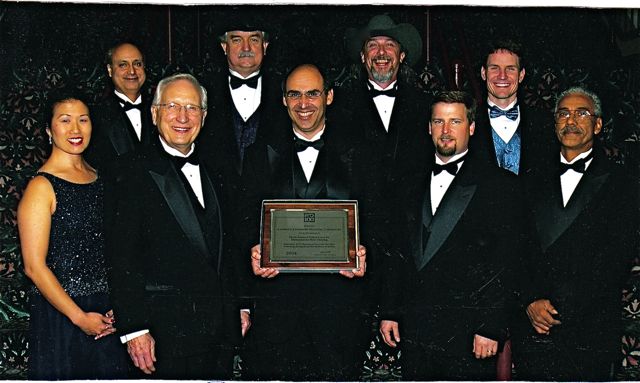
To achieve longer intervals of operation, we invented a gatling gun like machine, which by operating 5 stages of 8 laser crystal slabs per stage would be able to fire continuously for up to 10 seconds while producing 100 Kilowatts. We prepared a patent disclosure demonstrating the practical application of this device entitled, “The Rotating Slab Exchange (RSX) System.”
Just before I retired, the 5 crystal slab configured Solid State Heat Capacity diode pumped Laser system reached another important mile stone: it produced 62 Kilowatts of laser beam power for 6 seconds with a laser wave front of sufficient uniformity to be projected effectively 2 kilometers. (At about the same time Army Missiles System Division test results with a ground-based flash-lamp pumped laser producing 20 kilowatts integrated with a Boeing target acquisition and tracking system at White Sands Alamogordo Army Test Range demonstrated shooting down artillery, and mortar shells at that distance. )

